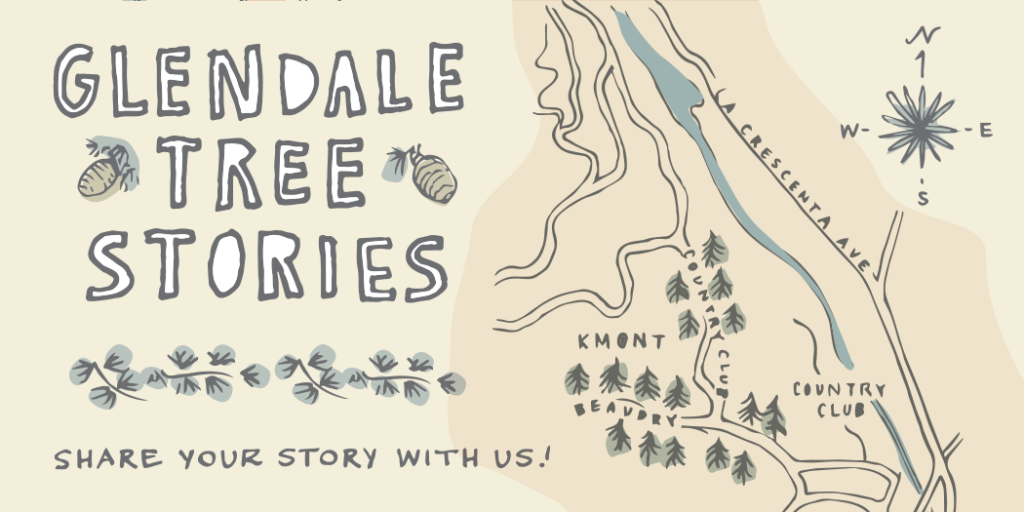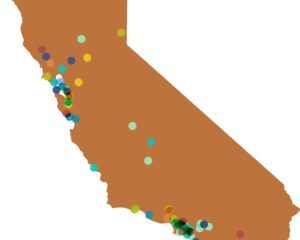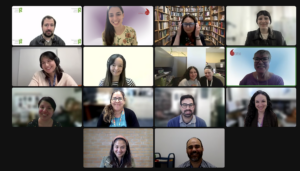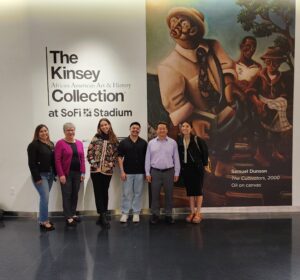Glendale Tree Stories is a public story-sharing project that seeks to elevate, celebrate, and archive residents’ shared histories with the urban forest. Supported by a Humanities for All Project Grant, the City’s Forestry Section is inviting residents to share a story about their favorite tree. The team collects and transforms these stories into a visually illustrated history with the help of local artist Elkpen. You can follow the project on the City of Glendale’s Instagram account @myglendale and #glendaletreestories.
In recognition of Earth Day this April, we asked Project Director Katherine Williams to share more about the process and inspiration behind the cities’ project.
What inspired you to do this project?
As part of the City’s Public Works Maintenance Services Division, Forestry staff get to hear tree stories all the time. Residents call us for help with not only their street trees but also native trees, like oaks and sycamores, protected under the City’s Indigenous Tree Ordinance. It is a joy when residents share where a bobcat was seen climbing one night or reminisce about the trees from their childhood in another country. Even when someone is unhappy with a tree, there is something special about getting a glimpse into the complicated relationships people have with urban nature.
What types of storytelling (collecting and sharing) strategies does your project involve? Why did you choose these?
There are so many compelling and urgent stories out there to tell about trees. The urban forestry world works hard to educate and inspire the public with stories about tree biology, natural history, and stewardship. We wanted to use this opportunity to take a step back and explore the personal voice and lived experience around trees. That is why we are collecting stories from the public using prompts like “what tree reminds you the most of home?” and “is there a tree you enjoy visiting every time you go to a certain park?” Having our very thoughtful and talented artist, Elkpen, interpret and transform these stories into gorgeous, illustrated comics helps reveal their inherent magic and honors them with the craftsmanship they deserve.
What efforts are you making to ensure that this project reaches widely and deeply into Glendale’s diverse population? Can you describe some of the ways you address language, culture, the digital divide through your project activities?
Fortunately, our project directive is straightforward—get stories, share stories! That means we can be relatively responsive to reaching our many audiences. In addition to our main project platform on Instagram, we provide stamped and addressed postcards to community hubs for off-line story submittals. Ultimately, the end product will be available online and in printed materials available to the public. Most importantly, we are networking with other City Departments and local community groups to get feedback on what is working and what may improve our outreach strategies.
What successes and challenges have you encountered so far? Have your plans shifted because of the pandemic?
We have been thrilled by the poignant, surprising, and fascinating stories shared with us so far. Our topic turned out to be very relevant to the last year, as attention shifted to how outdoor spaces and urban nature support public health, not least of all mental and emotional wellness. Now that we have such great stories to feature and share, we feel even more responsible for promoting it to a wider audience. So, we are trying to learn how to produce the project and increase our social media engagement at the same time!
As a city agency, what unique factors have you considered in designing and implementing this project? Are there advantages and/or challenges?
The City is an incredible resource for our project, and it has become a great opportunity to build relationships with other Departments. We are very grateful to the many City staff who have given their time to make this project happen, on top of their regular duties and workloads.
April has become a time to reflect on our relationship with nature – how can projects like this one contribute to raising public awareness and promoting thoughtful consideration and engagement with the challenges our communities face around climate change and other environmental issues?
We hope Glendale Tree Stories will highlight a connection to urban nature that already exists throughout every corner of our community. Sharing and celebrating common values around trees is one step towards building consensus around protecting and preserving these natural resources for future generations. Our ultimate goal for this project is to demonstrate Glendale’s incredible diversity while bringing a shared vision of its “tree stories” to life.

Glendale Tree Stories is supported by a Humanities for All Project Grant. Discover more about the project at https://www.glendaleca.gov/government/departments/public-works/indigenous-tree-program/glendale-tree-stories.





